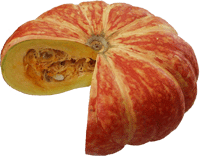 © Copyright Ginette George |
Pumpkin
|
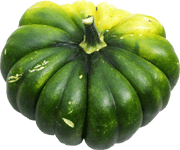 © Copyright Ginette George |
Squash, Pumpkins and Gourds are the common name for a group of vegetables which represents the Cucurbitacea cucurbita family.
These plants have characteristically spreading vines with showy yellow-orange flowers, large lobed leaves, and long twisting tendrils.
Jaune Gros de Paris and the Rouge Vif d'Etampes are the most famous pumpkins in France. However there is another one less common but very tasty, the Kabosha, also called Red Kuri or Potiron doux d'Hokkaido. Its skin is usually red but can also be green. Its orange flesh is creamy, sweet and nutty. In French, its name is POTIMARROM. It comes from its chestnuts (marron) taste.
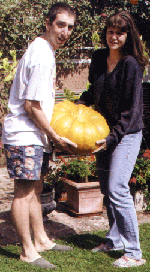 © Copyright Monique Livernais |
Health benefits Pumpkin is really low in calorie (20 cal per 100 g). The perfect vegetable for persons who watch their weight. The bright orange flesh of pumpkin is loaded with beta-carotene. Pumpkin seeds can also be eaten dried. |
|
|
Pumpkin seed oil is not made from those seeds but from Styrian pumpkin (Cucurbita Pepo). |
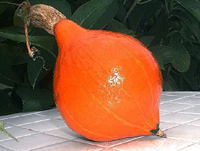 © Copyright Monique Livernais |
How to eat them?
Before using, rinse off any dirt.
Cutting the pumpkin may be challenging, use a large knife with a long handle.
Once cut in small pieces, you can then remove the seeds, the fibers and the skin.
You can also cook the whole pumpkin and cut and peel it afterwards. Make some holes in the pumpkin and place it the oven until the skin caramelized.
The pumpkin can be boiled or steamed until tender.
You can then smash it into a puree or a soup.
Shredded or diced, the pumpkin can be sauted in an oiled skillet and served as a side dish.
Kabocha can be eaten raw.
Its flesh is dense and can be shredded. You may want to serve it as a salad along with walnuts, raisins and cheese.
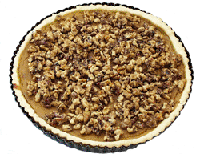 ©Copyright Sylvie George |
Everybody now knows the famous Halloween pumpkin pie. Many desserts are also made with pumpkin such as muffins, cookies, cakes... |
If you are interested in preparing these vegetables you can find many recipes in these books:
« Cucurbitacées, rapide et facile » Garance Leureux, Editions La Plage
« Trésors de courge et de potirons » Bruno Defay, Editions Terre Vivante.
Peak season
Choosing squash is easy.
Opt for those that are firm, heavy, smooth and free of blemishes.
Pumpkin is a winter vegetable. Fresh pumpkins are available only in the fall and early winter.
Storage
Pumpkin keeps well when uncut and placed in a cool and dry area. Allow for air circulation between the pumpkins.
Handle the pumpkin carefully since any bruises will cause the vegetable to rot.
In these conditions a pumpkin can be kept for up to three months.
Cut a pumpkin must be eaten in the week. Place it in a plastic bag and in the fridge.
Nutritional values
|
Nutrients
|
Units
|
Pumpkin raw
|
Pumpkin cooked, drained (whitout salt)
|
Pumpkin seeds dried
|
|
Water
|
g
|
91.6
|
93.69
|
6.92
|
| Energy |
kcal
|
26
|
20
|
541
|
| Protein |
g
|
1
|
0.72
|
24.54
|
| Total lipid (fat) |
g
|
0.1
|
0.07
|
45.85
|
| Carbohydrate |
g
|
6.5
|
4.89
|
17.81
|
| Fiber, total dietary |
g
|
0.5
|
1.1
|
3.9
|
|
Minerals
|
||||
| Calcium |
mg
|
21
|
15
|
43
|
| Iron |
mg
|
0.8
|
0.57
|
14.97
|
| Magnesium |
mg
|
12
|
9
|
535
|
| Phosphorus |
mg
|
44
|
30
|
1174
|
| Potassium |
mg
|
340
|
230
|
807
|
| Sodium |
mg
|
1
|
1
|
18
|
| Zinc |
mg
|
0.32
|
0.23
|
7.46
|
| Copper |
mg
|
0.127
|
0.091
|
1.387
|
| Manganese |
mg
|
0.125
|
0.089
|
3.021
|
| Selenium |
mcg
|
0.3
|
0.2
|
5.6
|
|
Vitamins
|
||||
| Vitamin C |
mg
|
9
|
4.7
|
1.9
|
| B-1 (thiamin) |
mg
|
0.05
|
0.031
|
0.21
|
| B-2 (riboflavin) |
mg
|
0.11
|
0.078
|
0.32
|
| B-3 (niacin) |
mg
|
0.6
|
0.413
|
1.745
|
| B-5 (pantothenic acid) |
mg
|
0.298
|
0.201
|
0.339
|
| B-6 (pyridoxine) |
mg
|
0.061
|
0.044
|
0.224
|
| Folate |
mcg
|
16
|
9
|
58
|
| B-12 |
mcg
|
0
|
0
|
0
|
| Vitamin A |
mcg RE
|
160
|
108
|
38
|
| Vitamin E |
mcg ATE
|
1.06
|
1.06
|
1
|
|
Lipids
|
||||
| Fatty acids, saturated |
g
|
0.052
|
0.037
|
8.674
|
| Fatty acids, monounsaturated |
g
|
0.013
|
0.004
|
14.258
|
| Fatty acids, polyunsaturated |
g
|
0.005
|
0.004
|
20.904
|
| Linoleic acid (18:2) |
g
|
0.002
|
0.002
|
20.702
|
| Alpha-linolenic acid (18:3) |
g
|
0.003
|
0.002
|
0.181
|
| Cholesterol |
mg
|
0
|
0
|
0
|
